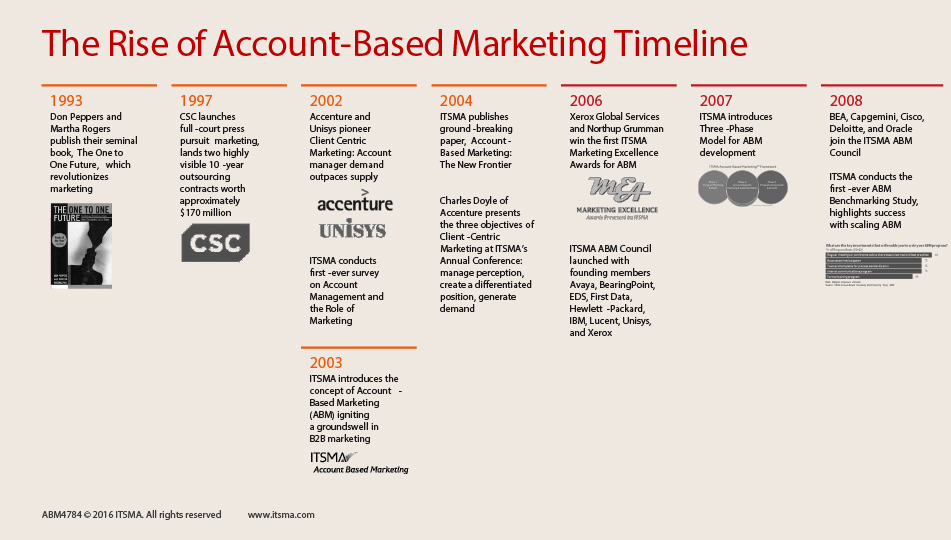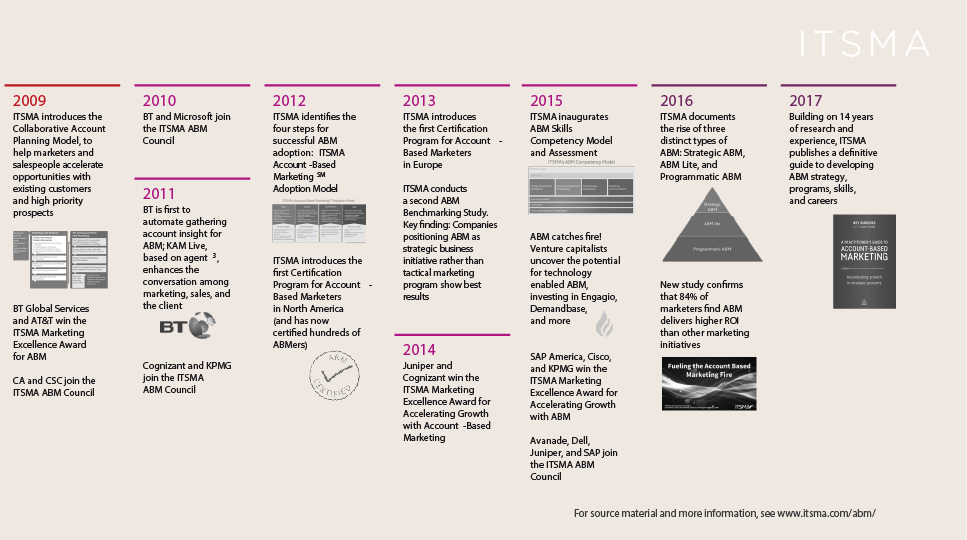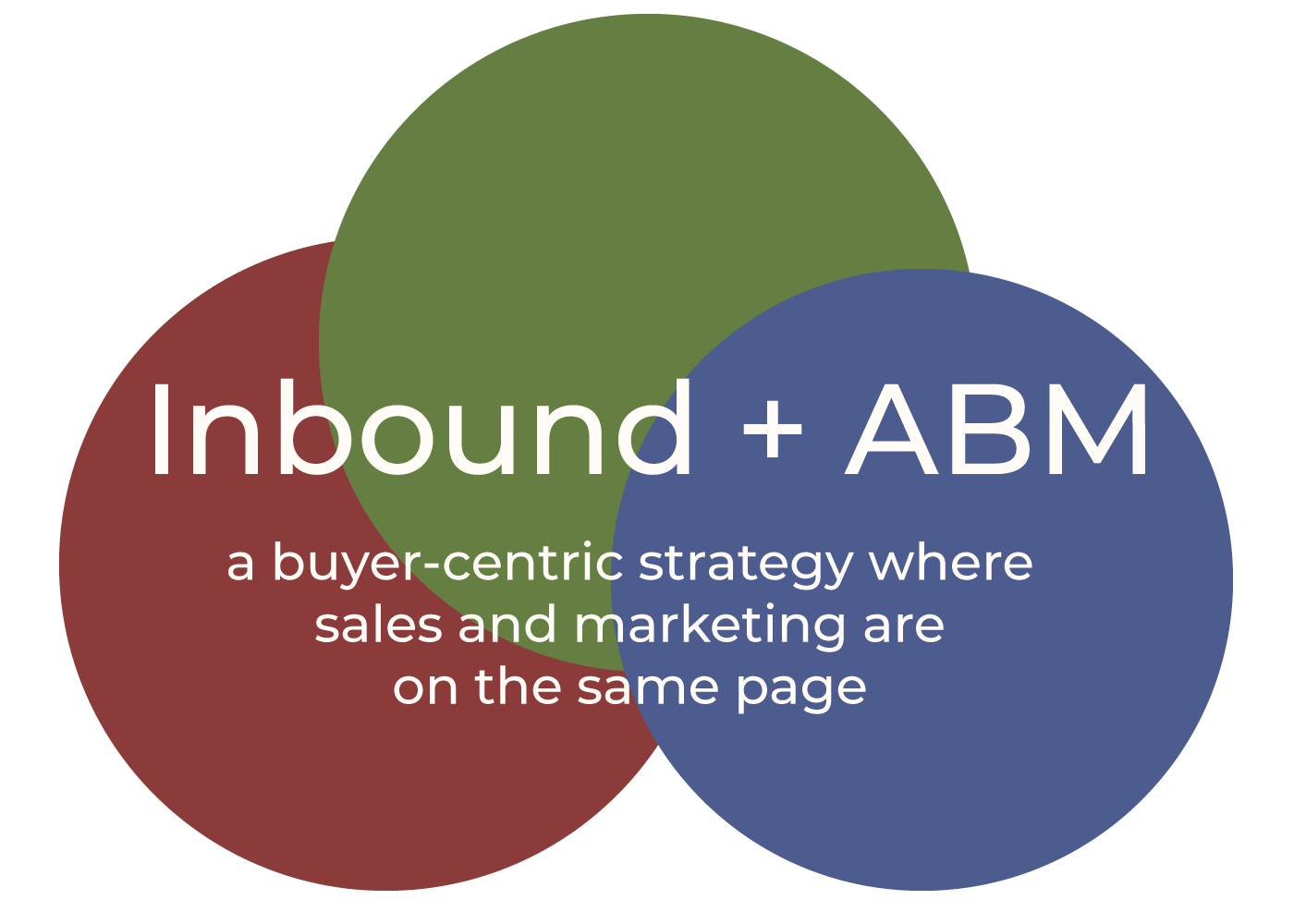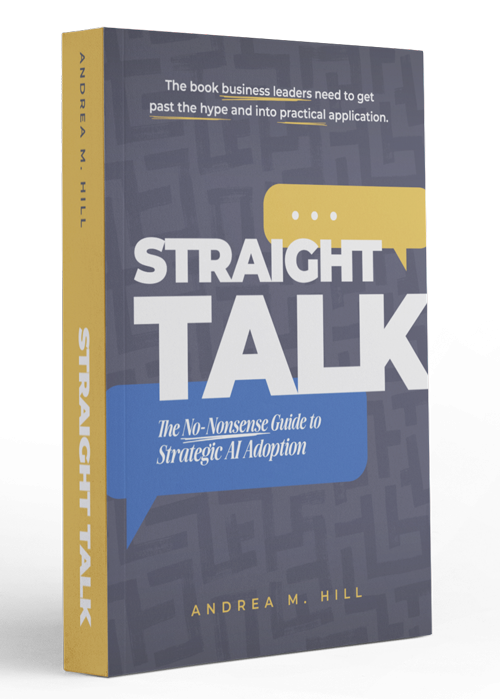How to Execute an ABM Selling Strategy

No More Forms, SPAM, Cold Calls or Begging for Trade Show Appointments. Win New B2B Clients with an ABM Strategy.
Account-Based Marketing 101: What it is, tools to consider, and how to execute a flawless campaign.
Account based marketing (ABM) is a powerful tool in any marketer’s tool belt, especially if your annual contract value (ACV) is high and relative number of opportunities in your market are low.
ABM requires tight cooperation between marketing and sales, so it is important that every team member involved has a common understanding of what ABM is and the tools and techniques needed to ensure ABM success.
First, a bit of ABM history
Mahy of the individual practices that make up ABM started long before ABM was packaged as a specific practice. The term itself was first introduced by the IT Services Marketing Association (ITSMA) in 2003, and then further developed in a groundbreaking 2004 paper titled Account Based Marketing: The New Frontier.
Despite ABM’s enduring presence as a marketing strategy (considering how quickly trends can come and go, at least!) it is still largely misunderstood by the modern marketer.


Here’s what ABM is not
In order to help us to understand what ABM is, let’s take a look at four things that ABM is not.
- Account based marketing is not a stand-alone practice that is mutually exclusive to other forms of marketing. It is a framework and a philosophy to place your tactics and strategies within. You can run inbound marketing as a part of ABM. Demand generation (like paid ads) can be a component of ABM. Social media can be a component of ABM. Webinars, content campaigns, and in-person events can all be a part of your ABM campaign.
- ABM is not just demand generation with some additional focus on accounts. Demand generation can be a complementary piece of your ABM campaign, but the two are not one and the same. Demand generation focuses on driving demand rather than leads and requires sales and marketing to work together on lifecycle stage definitions and handoffs, so while demand generation as a tactic can fit within the ABM framework, they are not the same thing.
- ABM and using intent data are not one and the same. You can run ABM without intent data and you can use intent data without running an ABM play. Intent data helps you gain relevance in any marketing play, when deployed properly, but is not required to be relevant or personalized. Remember, ABM has been around since 2003, long before the ZoomInfos and Bomboras of the world were around to tell us our prospect’s every move.
- Account planning and ABM are not the same thing. Does ABM involve account planning? Yes. Does every team doing account planning have to run an ABM campaign? No. Account planning is a sales strategy that can happen in a silo or in conjunction with marketing in order to align marketing with the account planning done by sales.
So what is ABM?
Account-based marketing is a hyper-personalized marketing practice that aligns marketing and sales in the pursuit of selling to target accounts. Let’s break that down a bit.
Instead of having the marketing team drive leads and try to qualify them, then throw them over the wall to the sales team, which tries to convert them, in ABM the marketing and sales teams work closely together to define a clear set of target companies they want to win as clients. This involves:
- Aligning not only marketing and sales, but also operations and customer success teams, to work more closely together and in a different way than they have in the past. ABM-practicing companies tend to call these revenue teams.
- Learning how to identify buying signals of B2B buyers who are doing anonymous website visits, online research, buying 3rd party research, and otherwise controlling the sales funnel far longer than B2B buyers controlled the funnel in the past.
- Identifying all the employees at each company who would be involved in or influence a purchasing decision.
- Gathering accurate, reliable data to pursue those clients.
- Creating meaningful customer profiles and customer journeys using the input of all revenue team members.
- Creating the right content to deliver to targeted customers at the right time, relying on simple, streamlined technology that facilitates the delivery process and keeps all revenue team members coodinated.
The coordinated efforts of ABM result in three major benefits:
- Increased revenue
- Increased sales productivity
- Greater trust from target accounts, earned through being hyper customer-centric.
In ABM, since marketing and sales are so closely aligned, the customer experience is seamless and completely relevant to their place in the buyer’s journey. From the very first impression at top of funnel (ToFu) to the assets that sales uses in the discovery process and beyond, marketing and sales are in lockstep.
This alignment and customer obsession – as well as the tactics and strategies you deploy – are what make ABM so effective.
ABM Acronyms & Jargon
Marketing and sales are disciplines filled with jargon and acronyms. If you’re running an ABM play, it’s helpful to make sure your marketing and sales teams are clear about what is meant when ABM buzzwords inevitably start getting thrown around. Here are seven you’ll want to know:
- ICP - This is your ideal customer profile. The ICP is usually created using a combination of firmographic, technographic, and demographic factors and is an essential guide to whether an individual account is one you should target or not. Many companies use ICP tiers to guide marketing and sales tactics & strategies based on tier or how valuable the account is to your business
- TAL - Target Account List. This is a list of accounts that you have identified as high-value that you will target in your campaigns. This can be done by choosing individual accounts or by using your ICP to find accounts that match those parameters
- Buying Committee - this is the group of stakeholders that you are seeking to influence within your ABM campaigns because they have a seat at the decision-making table. Potential buying committee members include decision makers, influencers, budget holders, blockers, champions, legal, and end users.
- Air Cover - This is a marketing play where you ensure that the buying committee is seeing relevant ads throughout the buyer’s journey. Air Cover is designed to ensure you are omni-present and to influence multiple people at your target accounts.
- Surfacing Leads or Handoffs - This is a sales and marketing alignment term that speaks to the timing and mechanisms for putting a lead in front of your sales team. For example, you may put your tier 1 target accounts in front of sales via a task and a Slack notification when the target account has a company score of 100.
- Thought Leadership - This term is applicable to other forms of marketing, but it is especially important in ABM. Thought leadership is a demonstration of your expertise on a particular topic. In ABM, this expertise is shared via social media posts, video content, podcasts, guides, and other content assets. Thought leadership helps you to position yourself while also providing value to your target accounts.
- Sales & Marketing Alignment - Necessary for running ABM plays, sales and marketing alignment involves sales and marketing collaborating on accounts to target, when to hand off those accounts based on ICP tier, lifecycle stage definitions, what content sales should use for various target accounts, and more. Sales and marketing alignment is about breaking down silos and making your revenue team more effective through working together.
So You’re Sold on ABM … Now What?
While ABM campaigns can be complex, setting up a solid foundation for your campaign is pretty simple if you follow these steps:
- Identify your ICP, create your TAL, and segment your TAL into tiers - Any good marketing strategy starts with the audience. Who are you targeting? Whether you start with a hand-selected list of accounts or use your ICP parameters to pull a matched list from a 3rd party tool, the first step is to identify who you are targeting and to segment that list as necessary.
- Plan touchpoints and triggers per tier and/or buying role - Now that you know who you are targeting, you need to build out the buyer’s journey for each ICP tier, buying role, job function, etc. We recommend doing this with a tool like LucidChart.
Remember, you will want to plan all of your triggers, conditions, exclusions, lifecycle stage qualifications, etc. Make your schematic or roadmap as complete and thoughtful as possible (or let WerxMarketing walk you through it! Our Customer Journey process is designed to leave you with clarity about your ICP and deliver the building blocks of your ABM strategy. Click here to book a consult).
Don’t let your plan be incomplete! It’s better to keep your plan simple and complete, than to make it overly complex and leave elements out or end up with confusing or incongruent steps. Keep your team’s bandwidth in mind when deciding how segmented and personalized you need to be in your campaigns.
- Align sales and marketing on the handoff - Handoffs are everything when it comes to your ABM campaign. Sales and marketing need to be on the same page about when sales gets involved, how marketing shifts when that happens, and if the handoff is the same for every ICP tier and buying role. Once these handoffs are agreed upon, they should be set up in your CRM & marketing automation platform. At WerxMarketing we are certified in several CRM platforms. For ABM work, we recommend HubSpot. It is the best tool for integrating the full portfolio of selling and marketing activities necessary for ABM in a simple, easy-to-learn, easy-to-use system.
- Deploy your complete strategy & schedule ongoing alignment check-ins - Before you launch your campaign, be sure to double-check all your segmenting workflows, lead surfacing conditions and asset delivery settings. Once you have tested the set up and pushed your campaign out into the world, you will want to monitor your dashboards and ensure that you use regularly scheduled meetings between sales and marketing to stay aligned.
- Iterate and experiment to boost relevance - After you have launched you will need to analyze your performance and optimize in the same way that you would for any other marketing campaign. In addition to the standard KPIs, you will also want to keep an eye on how your campaigns perform across entire accounts rather than with the individuals who comprise accounts. Keep track of which assets are hitting with which buying roles, job functions, and ICP tiers. Evaluate what handoff patterns deliver the best closed-won opportunities. And, as always, collect customer and sales team feedback to gather insights that your dashboards don’t tell you.
What tools are needed to run an effective ABM campaign?
We mentioned earlier that we believe HubSpot is the best CRM tool for managing ABM campaigns. If you are already invested in a CRM, we can help you maximize the value of it for ABM purposes (Werx.Marketing maintains certifications in a number of CRM technologies). Or, if you've grown out of your CRM's capabilities, we can easily migrate you to the better tool. But regardless which technology you are using, let’s dig into the HubSpot platform a bit more to illustrate some of the technical support needed for ABM and to understand why we recommend HubSpot and how you might use it for your own ABM initiatives.
There are dozens of tools that enable ABM, and many of them can be used together for even stronger management and results. Let’s look at a few here:
HubSpot: CRM, Marketing Automation, Reporting
HubSpot allows you to run your ABM campaigns end-to-end right inside of your CRM. The fact that you can keep your data clean, ensure account visibility across marketing and sales, and scale your campaign with epic automations make HubSpot a great choice to be the backbone of your ABM campaigns.
RollWorks - Customer Intent Data, Marketing Automation, Reporting, Ad Delivery, AI Optimization
RollWorks can be used as a stand-alone platform, but it is best used in conjunction with a CRM like HubSpot. RollWorks provides customer intent data and a bevy of firmographic, demographic, and technographic data points to use when building out your ICPs and TALs. It then allows you to deploy those audiences through multiple channels, ensuring your messaging is relevant for buyers no matter where they are in their journey.
Terminus: Customer Intent Data, Marketing Automation, Reporting, Ad Delivery, AI Optimization
Terminus, like RollWorks, aims to cover the complete ABM cycle in one platform and conveniently plugs into a CRM like HubSpot. When you combine Terminus’ omni-channel personalization capabilities and intent data with your HubSpot record activity, segmented lists via automation, and other CRM data, you empower your marketing team to deliver customized account-based experiences at scale.
DemandBase: Customer Intent Data, Marketing Automation, Reporting, Ad Delivery, AI Optimization
DemandBase was built with B2B and ABM in mind. Seeking to unite account-based motions across the entire flywheel (a practice known as ABX), DemandBase provides an easy-to-use tool that assists with account selection, targeting, ad delivery, and omni-channel optimization for better ABM outcomes. With a hefty list of integrations, DemandBase is well positioned to partner with your CRM to deliver highly relevant content and campaigns.
Powerful Integrations for Elevated ABM Campaigns
Another reason we recommend HubSpot for your ABM campaigns is its suite of fully-integrated tools.
HubSpot was built around the same customer-obsessed ethos from which ABM was born, so it makes sense that it’s a natural fit for ABM campaigns.
The HubSpot CRM platform connects all the data from your sales and marketing efforts while allowing for robust, customer-centric automation and personalization. With an ABM campaign powered by HubSpot’s powerful CRM platform, you’re empowered to use data to segment and target your accounts and automation to nurture your buying committee and to hand warm leads over to sales. But that’s not all – check out the following HubSpot features that align with the tenants of successful ABM:
Single Source of Truth
- Shared view of all object records
- ABM tools
- Default ABM properties
- Target accounts home
- AI-powered Target Account recommendations
- Account overview page
- Operations Hub for data cleanliness and consistency
Streamlined Campaign Deployment
- Ads – company targeting
- Forms – company properties
- Smart content
- Landing pages
- Campaigns
- Workflow automations
- Company lists
Integrations Galore
- Slack for account based collaboration
- Postal.io for offline marketing & gifting
- ZoomInfo for contact enrichment
- Bombora for intent data
- Zoom for webinars
- Clearbit for account enrichment
- LinkedIn Sales Navigator for account planning & building
- Enhanced Salesforce sync for ABM
Seamless Handoffs = Seamless Customer Experience
- Advanced sequences
- Company scoring
- Marketing automation: lifecycle stage and lead status management
- Lead rotation
- Tasks and notifications
- Custom behavioral events
- Lead scoring
- Chat bots/live chat
- Default workflows
- Quotes
- Tasks
- Meetings
- Documents
- HubSpot video
Reporting and Revenue Attribution
- Custom reports
- Sales and marketing analytics
- Dashboards for ABM, sales, and marketing
- Conversational intelligence
- Ad conversion events
- Web, ad & social media analytics
Executing ABM Campaigns in HubSpot
We have covered a lot of ground at this point, so let’s jump into the deep end and take a look at some specific ways you can leverage HubSpot’s Sales Hub and Marketing Hub to power your ABM plays. This will help you picture how to manage the information and team collaboration necessary for success.
- Create a target account list by adding AI-suggested target accounts, viewing prospects in the prospect tool, or importing target accounts using an integration with a third party tool like LinkedIn Sales Navigator, ZoomInfo, Bombora, Terminus, or RollWorks
- Track and view account activity in the account overview panel to view all touches and interactions across the entire buying committee in one place, ensuring both sales and marketing have a clear understanding of the state of each target account
- Use workflows to label your ICP tiers and buying roles, and use company lists to group your target accounts and buying committee to leverage with company targeting in your campaigns.
- Use the campaigns tool to plan and deploy all of the touches and asset iterations for your AMB plays. Social media, ads, landing pages, forms, emails, and much more can be added to a campaign to roll up reporting & results into one view across multiple assets.
- Use smart content and A/B testing on your landing pages to give a personalized experience, and leverage chat bots to ensure your prospects can find what they need.
- Use workflows and 3rd party integrations to continuously segment your lists and to update an account’s ad and other targeting based on engagement, intent, scoring, etc.
- Update lifecycle stage and lead status based on behavior or custom events and sync your lifecycle stages with external ad platforms for better AI optimization for your ad campaigns.
- Automatically update marketing plays based on buying role, ICP tier, buying stage, and more using workflows.
- Use workflows and company scoring to surface accounts to sales at the right time and keep sales in the know, moment by moment, of account activity using the Slack integration.
- Use Operations Hub data quality features to ensure that all data syncing between tools is clean and consistent
- Automate the work of your sales team by leveraging workflows to assign tasks and send notifications
- Research active prospects and accounts with the LinkedIn Sales Navigator integration right inside of HubSpot and make your outreach timely and relevant
- Enroll buying committee members into sequences automatically based on any of over a thousand trigger options. Essentially, any information about the account can be utilized to determine the right time to enroll an account into a sequence
- Suggest content for sales to use in the buying process based on prospect’s consumption history using workflows and user behavior data to personalize the journey
- Use HubSpot videos in your sales outreach for personalization.
- Use workflows and offline marketing integrations like postal.io to automatically send gifts to your buying committee based on deal size, ICP tier, lifecycle stage, deal stage, and more.
- Analyze data across the entire buyer’s journey in one place with reports and dashboards, collaborate on changes with the campaign tool, and implement iterations and optimizations into your campaigns all from HubSpot.
Expand the HubSpot Platform with Integrations to Fuel Your ABM Campaigns
Intent Signals
ZoomInfo (Elite Plan)
ZoomInfo gives you a few tools to make your ABM campaigns better than ever! First of all, you can enrich contact data so that you have emails and phone numbers for your buying committee. This allows your sales team to begin outreach before a contact submits their information to your CRM, which is helpful for outbound sales motions.
The true power for ABM comes from the intent data that ZoomInfo has. Using ZoomInfo workflows and the HubSpot integration, you can add Target Accounts that are showing intent to specific lists. With those lists, you can leverage HubSpot’s powerful workflow automations to update the marketing mix for those in-market accounts. This means that you can be more personalized and relevant in your efforts.
Bombora (Ads or CRM product)
Bombora offers the same functionality as ZoomInfo but without the contact enrichment. This solution can be a more affordable option for companies looking for intent data without contact enrichment features. Bombora is the original platform when it comes to buyer intent data and has a large number of platform partnerships to collect first-party intent targeting data.
Bombora also has an ad solution that allows you to deploy your B2B audiences on display networks that don’t connect to HubSpot.
G2 and Gartner Media
G2 and Gartner are both software review companies with platforms that allow people to review and compare software options. This tool is very powerful for SaaS companies or service providers whose services center on specific software products.
While Gartner Media’s platforms present software options based on who bids for the top spot, G2’s rankings are only driven by reviews of the software products.
Both companies allow you to pipe data from their platform into your CRM for marketing and sales initiatives. G2 even allows you to layer on Bombora intent topics on top of their intent data for hyper-targeted campaigns. The data provided to you by G2 allows you to target those who have looked at your product, your category, and your competitors. Gartner’s data is similar.
Better Campaigns
Have you ever wished that you could send a gift to a prospect automatically when they reached a certain lifecycle or deal stage? You can do that and much more with postal.io!
Customize the gifts you send based on deal size, buying role, ICP tier, and more. You can even send a collection of gift options to allow your prospect to choose what they prefer. Strategically put your brand in the hands of your target accounts at the right moments throughout the buying process.
Like Postal.io, Postalytics allows you to deploy direct mail based on whatever triggers you set up in HubSpot workflows. This can be a very powerful tool to use top-of-funnel when you are building awareness and making your buyer aware of the problems that you can help them fix.
Easy to set up and well-integrated with HubSpot, Postalytics is a great complement to your inbound & ABM campaigns.
Are You Already Using Inbound/Organic SEO as a Marketing Strategy?
Inbound and ABM go together like peas and carrots. Both based on delighting the customer and driving value first, it is no wonder that so many marketers combine these two practices for digital marketing bliss. What makes these two approaches so complementary? Think about it:
- Inbound focuses on giving the customer what they want and need at each step of the buyer’s journey – it is buyer-centric.
- ABM focuses on using deep account knowledge to personalize the buyer’s journey at scale, focusing on an entire account/buying committee.
- ABM requires sales and marketing alignment and allows sales to spend more time on the right leads.
When you put these two practices together, you deliver an experience that makes prospects delight in interacting with your brand.

Data from HubSpot shows that users have seen impressive results when they combine the Marketing and Sales Hubs for sales and marketing alignment:
HubSpot has also published that customers combining the MarketingHub with SalesHub also see their customers engage more, their pipelines grow faster, and their sales team spending more time focused on building revenue-growing relationships with their prospects.
Data from the Map My Customers case study & Binary Streams study
Summary
In summary, if you’re looking for a marketing strategy that gets you out of the frantic advertising search for leads, and instead puts you in the drivers' seat pursuing the accounts you want, ABM is the strategy you're lookign for. ABM is a powerful practice, especially when paired with inbound marketing and deployed in a single, streamlined system that delivers a seamless customer experience.
We also think you should consider HubSpot as your one-stop shop. Of all the CRM systems Werx.Marketing implement and supports, HubSpot is the best overall choice for an ABM strategy.
The benefits of using HubSpot for account based marketing plays are plentiful. It’s the best-in-class platform for ABM for the following reasons:
- Keep your team in one reliable, trusted tool with a shared view of company, contact, and deal records
- Transparency from start to finish to keep teams aligned
- A powerful workflow automation tools to give your customers a seamless experience
- Plentiful integrations to add functionality and customer data to your campaigns
- Personalize the buyer’s journey, account by account and buying role by buying role
- Build out your entire strategy in HubSpot for smooth handoffs using native ABM tools
- Analyze and iterative on the spot for increased success over time with reporting and analytics
- Attribute your results to your marketing efforts with omni-channel activity tracking
Ready to get started?
Let the team at WerxMarketing show you how we can help you with the technology, the training, and the cultural change to fully adopt an ABM strategy. Call us at 312.239.8820 X 704, or book a free consult.
Andrea Hill's
Latest Book
Straight Talk
The No-Nonsense Guide to Strategic AI Adoption

Where other books focus on prompts and tools, this book gives business leaders what they actually need: the frameworks and confidence to lead AI adoption responsibly, without having to become technologists themselves.
Also available at independent booksellers and public libraries.
Are You Ready to Do Better Marketing?
WerxMarketing is all about performance marketing. That means giving you the tools you need to connect with customers, enable your sales efforts, and turn leads into loyal customers. Ready to learn more about how we do that? Book a free consult and bring your questions. See if you like working with us on our dime, and get some good advice in the process.
